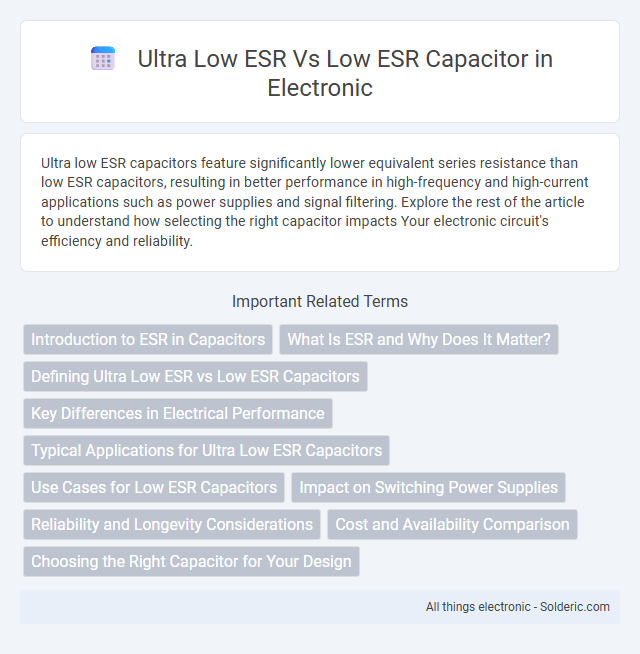Ultra low ESR capacitors feature significantly lower equivalent series resistance than low ESR capacitors, resulting in better performance in high-frequency and high-current applications such as power supplies and signal filtering. Explore the rest of the article to understand how selecting the right capacitor impacts Your electronic circuit's efficiency and reliability.
Comparison Table
| Feature | Ultra Low ESR Capacitor | Low ESR Capacitor |
|---|---|---|
| Equivalent Series Resistance (ESR) | Typically < 5 mO | Typically 5 mO to 50 mO |
| Applications | High-frequency switching power supplies, RF circuits, automotive electronics | General power supply filtering, decoupling, smoothing |
| Performance | Superior ripple current handling, minimal heat generation | Good ripple current handling, moderate heat generation |
| Cost | Higher due to advanced materials and construction | Lower, suitable for standard applications |
| Size | Typically smaller for same capacitance | Typically larger for same capacitance |
| Reliability | Enhanced under high stress and high frequency | Standard reliability |
Introduction to ESR in Capacitors
Equivalent Series Resistance (ESR) in capacitors represents the internal resistance that causes power loss and heat generation during operation. Ultra low ESR capacitors offer significantly reduced resistance compared to low ESR types, enhancing performance in high-frequency and high-ripple current applications. This reduction in ESR improves efficiency, reliability, and lifespan, making ultra low ESR capacitors ideal for power supply circuits and advanced electronic devices.
What Is ESR and Why Does It Matter?
Equivalent Series Resistance (ESR) represents the internal resistance within capacitors that affects their efficiency in filtering and energy storage applications. Ultra low ESR capacitors offer significantly lower resistance compared to low ESR types, resulting in improved performance for high-frequency circuits and reduced heat generation. Minimizing ESR is crucial in power electronics to enhance reliability, reduce power loss, and maintain stable voltage under rapid load changes.
Defining Ultra Low ESR vs Low ESR Capacitors
Ultra low ESR capacitors have equivalent series resistance (ESR) values significantly lower than standard low ESR capacitors, resulting in improved performance in high-frequency and high-current applications. These capacitors minimize power losses and heat generation, making them ideal for power supply filters and switching regulator circuits. Understanding the difference between ultra low ESR and low ESR capacitors helps you select components that optimize efficiency and reliability in your electronic designs.
Key Differences in Electrical Performance
Ultra low ESR capacitors exhibit significantly lower equivalent series resistance compared to low ESR capacitors, resulting in improved high-frequency performance and reduced heat generation. Their superior electrical conductivity enhances efficiency in applications such as power supplies and audio equipment where stable voltage and minimal signal distortion are critical. Choosing ultra low ESR capacitors can optimize Your circuit's reliability and longevity by minimizing energy loss and thermal stress.
Typical Applications for Ultra Low ESR Capacitors
Ultra low ESR capacitors are crucial in high-frequency switching power supplies, DC-DC converters, and automotive electronics due to their superior efficiency in reducing power loss and heat generation. These capacitors excel in applications requiring rapid charge and discharge cycles, such as CPU power regulation and RF circuits. Your designs benefit from improved reliability and performance when using ultra low ESR capacitors in demanding environments.
Use Cases for Low ESR Capacitors
Low ESR capacitors are essential in power supply filtering, decoupling applications, and voltage regulation modules because they minimize energy loss and heat generation under high ripple currents. Ultra low ESR capacitors, typically used in high-frequency switching circuits, offer superior performance in applications requiring rapid charge-discharge cycles, such as in computer motherboards or high-performance graphics cards. Your system benefits from choosing the appropriate ESR level based on operating frequency, current load, and thermal requirements to ensure stability and efficiency.
Impact on Switching Power Supplies
Ultra low ESR capacitors significantly reduce power loss and heat generation in switching power supplies compared to standard low ESR capacitors, improving overall efficiency and reliability. Their minimal equivalent series resistance enhances transient response and reduces voltage ripple, which is critical for high-frequency switching applications. Choosing ultra low ESR capacitors for your power supply design ensures better performance and longer component lifespan under demanding electrical conditions.
Reliability and Longevity Considerations
Ultra low ESR capacitors exhibit significantly enhanced reliability due to their superior internal resistance characteristics, which reduce heat generation and minimize degradation over time. This lower ESR directly contributes to extended operational longevity, making them ideal for demanding applications requiring stable performance under high ripple currents. In contrast, standard low ESR capacitors, while reliable, may experience quicker wear and performance decline in similar conditions, impacting overall device lifespan.
Cost and Availability Comparison
Ultra low ESR capacitors generally cost more than low ESR capacitors due to advanced materials and manufacturing processes required to achieve minimal equivalent series resistance. Availability of ultra low ESR capacitors may be limited, especially in specialized capacitance and voltage ratings, whereas low ESR capacitors are widely produced with broader market accessibility. Budget-conscious projects often opt for low ESR capacitors to balance performance and cost, while high-frequency or precision applications justify investment in ultra low ESR variants.
Choosing the Right Capacitor for Your Design
Ultra low ESR capacitors offer significantly lower equivalent series resistance than standard low ESR types, making them ideal for high-frequency switching power supplies and sensitive analog circuits requiring minimal voltage ripple. Choosing the right capacitor for your design depends on balancing ESR values to optimize efficiency, thermal performance, and signal integrity. Your selection should consider operating frequency, load conditions, and space constraints to ensure reliable, stable performance in demanding applications.
Ultra low ESR vs low ESR capacitor Infographic

 solderic.com
solderic.com